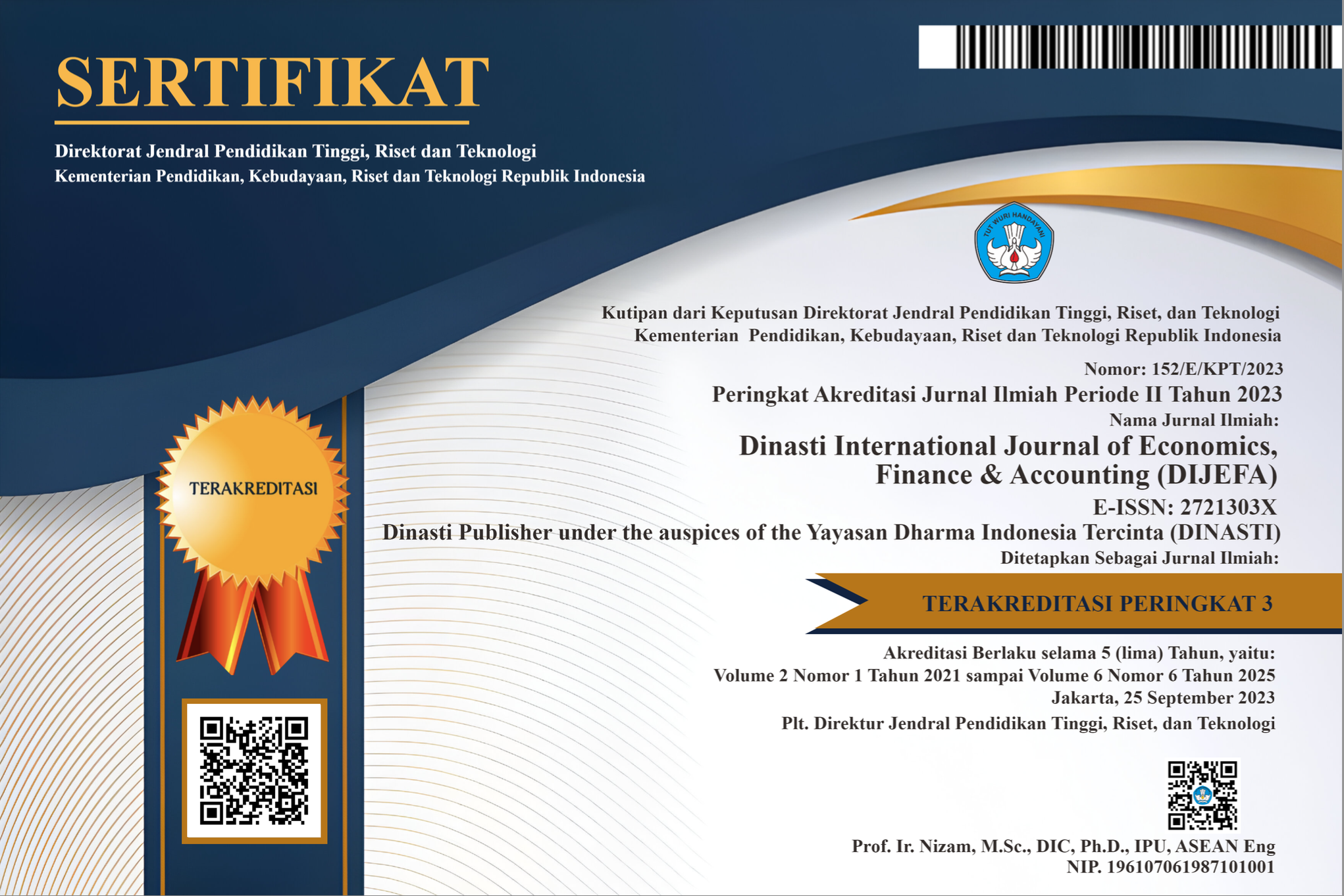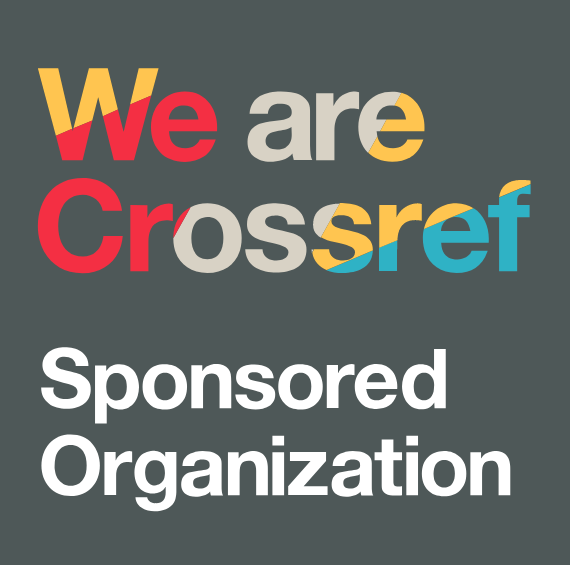Implementation of QRIS: A Case Study of SMEs in Indonesia
DOI:
https://doi.org/10.38035/dijefa.v5i3.2780Keywords:
Digital payment, Innovation Resistance Theory (IRT), SMEs, QRISAbstract
After COVID-19, one of the most widely used payment methods for online purchases is the Indonesian Standard Quick Response Code (QRIS), particularly since Bank Indonesia has accepted it. Utilizing the Innovation Resistance Theory (IRT) approach, which includes two primary components—psychological and functional—this study aimed to uncover impediments to the adoption of QRIS through the use of usage, value, risk, tradition, and image barriers. SMEs in the food and beverage industry that have implemented QRIS serve as the research’s unit of analysis. Ten Majalengka-based food and beverage SMEs participated in in-depth interviews as part of this case study-based qualitative research technique. The study’s findings demonstrate that QRIS has benefits that outweight its minor drawbacks for both SMEs and consumers. Large-scale QRIS socialization, optimization, and equitable use are also under the purview of the government.
References
References
Agresti, A. (2006). An Introduction to Categorical Data Analysis: Second Edition. In An Introduction to Categorical Data Analysis: Second Edition. https://doi.org/10.1002/0470114754
Alexandrou, A., & Chen, L. C. (2021). Correction to: A security risk perception model for the adoption of mobile devices in the healthcare industry (Security Journal, (2019), 32, 4, (410-434), 10.1057/s41284-019-00170-0). Security Journal, 34(2), 261. https://doi.org/10.1057/s41284-019-00223-4
Alkhowaiter, W. A. (2022). Use and behavioural intention of m-payment in GCC countries: Extending meta-UTAUT with trust and Islamic religiosity. Journal of Innovation and Knowledge, 7(4), 100240. https://doi.org/10.1016/j.jik.2022.100240
Arvidsson, N. (2014). Consumer attitudes on mobile payment services - results from a proof of concept test. International Journal of Bank Marketing, 32(2), 150–170. https://doi.org/10.1108/IJBM-05-2013-0048
Bank Indonesia. (2019a). Peraturan Anggota Dewan Gubernur Nomor 21/ 18 /Padg/2019 Tentang Implementasi Standar Nasional Quick Response Code Untuk Pembayaran. Bank Indonesia, 1–30.
Bank Indonesia. (2019b). QRIS. Bi.Go.Id. https://www.bi.go.id/QRIS/default.aspx
Chen, C. C., Chang, C. H., & Hsiao, K. L. (2022). Exploring the factors of using mobile ticketing applications: Perspectives from innovation resistance theory. Journal of Retailing and Consumer Services, 67(December 2021), 102974. https://doi.org/10.1016/j.jretconser.2022.102974
Chen, P. T., & Kuo, S. C. (2017). Innovation resistance and strategic implications of enterprise social media websites in Taiwan through knowledge sharing perspective. Technological Forecasting and Social Change, 118, 55–69. https://doi.org/10.1016/j.techfore.2017.02.002
Dahlberg, T., Guo, J., & Ondrus, J. (2015). A critical review of mobile payment research. Electronic Commerce Research and Applications, 14(5), 265–284. https://doi.org/10.1016/j.elerap.2015.07.006
de Kerviler, G., Demoulin, N. T. M., & Zidda, P. (2016). Adoption of in-store mobile payment: Are perceived risk and convenience the only drivers? Journal of Retailing and Consumer Services, 31, 334–344. https://doi.org/10.1016/j.jretconser.2016.04.011
de Luna, I. R., Liébana-Cabanillas, F., Sánchez-Fernández, J., & Muñoz-Leiva, F. (2019). Mobile payment is not all the same: The adoption of mobile payment systems depending on the technology applied. Technological Forecasting and Social Change, 146(September), 931–944. https://doi.org/10.1016/j.techfore.2018.09.018
Dubey, P., & Sahu, K. K. (2021). Students’ perceived benefits, adoption intention and satisfaction to technology-enhanced learning: examining the relationships. Journal of Research in Innovative Teaching and Learning, 14(3), 310–328. https://doi.org/10.1108/JRIT-01-2021-0008
Eneizan, B., Mohammed, A. G., Alnoor, A., Alabboodi, A. S., & Enaizan, O. (2019). Customer acceptance of mobile marketing in Jordan: An extended UTAUT2 model with trust and risk factors. International Journal of Engineering Business Management, 11, 1–10. https://doi.org/10.1177/1847979019889484
Eriksson, N., Gökhan, A., & Stenius, M. (2021). A qualitative study of consumer resistance to mobile payments for in-store purchases. Procedia Computer Science, 181(2019), 634–641. https://doi.org/10.1016/j.procs.2021.01.212
Haddara, M., Gøthesen, S., & Langseth, M. (2021). Challenges of Cloud-ERP Adoptions in SMEs. Procedia Computer Science, 196(2021), 973–981. https://doi.org/10.1016/j.procs.2021.12.099
Hayashi, F. (2012). Mobile Payments: What’s in It for Consumers? ECONOMIC REVIEW, 35–66.
Ibrada, A. S., Mulyani, S., Winarningsih, S., & Farida, I. (2020). User competency as an important factor for the success of AIS implementation: empirical study of the systems in distribution of subsidised fertilisers in Indonesia. Talent Development & Excellence, 12, 3012–3025.
Interactive. (2023). BI Naikkan Lagi Limit Transaksi QRIS Jadi Rp 20 Juta. https://qris.online/homepage/qris-news-detail?page=45-bi-naikkan-lagi-limit-transaksi-qris-jadi-rp-20-juta
InterActive. (2019). Tentang InterActive QRIS. Qris.Online. https://qris.online/homepage/about#:~:text=Apa itu QRIS%3F,ASPI) pada 17 Agustus 2019.
Junadi, & Sfenrianto. (2015). A Model of Factors Influencing Consumer’s Intention to Use E-payment System in Indonesia. Procedia Computer Science, 59(Iccsci), 214–220. https://doi.org/10.1016/j.procs.2015.07.557
Kaur, P., Dhir, A., Singh, N., Sahu, G., & Almotairi, M. (2020). An innovation resistance theory perspective on mobile payment solutions. Journal of Retailing and Consumer Services, 55(April), 102059. https://doi.org/10.1016/j.jretconser.2020.102059
Khayer, A., Talukder, M. S., Bao, Y., & Hossain, M. N. (2020). Cloud computing adoption and its impact on SMEs’ performance for cloud supported operations: A dual-stage analytical approach. Technology in Society, 60, 101225. https://doi.org/10.1016/j.techsoc.2019.101225
Kotkowski, R., & Polasik, M. (2021). COVID-19 pandemic increases the divide between cash and cashless payment users in Europe. Economics Letters, 209, 110139. https://doi.org/10.1016/j.econlet.2021.110139
Laukkanen, T., & Kiviniemi, V. (2010). The role of information in mobile banking resistance. International Journal of Bank Marketing, 28(5), 372–388. https://doi.org/10.1108/02652321011064890
Laukkanen, T., Sinkkonen, S., & Laukkanen, P. (2009). Communication strategies to overcome functional and psychological resistance to Internet banking. International Journal of Information Management, 29(2), 111–118. https://doi.org/10.1016/j.ijinfomgt.2008.05.008
Lian, J. W., & Yen, D. C. (2014). Online shopping drivers and barriers for older adults: Age and gender differences. Computers in Human Behavior, 37, 133–143. https://doi.org/10.1016/j.chb.2014.04.028
Lin, K. Y., Wang, Y. T., & Huang, T. K. (2020). Exploring the antecedents of mobile payment service usage: Perspectives based on cost–benefit theory, perceived value, and social influences. Online Information Review, 44(1), 299–318. https://doi.org/10.1108/OIR-05-2018-0175
Mallat, N. (2007). Exploring consumer adoption of mobile payments - A qualitative study. Journal of Strategic Information Systems, 16(4), 413–432. https://doi.org/10.1016/j.jsis.2007.08.001
Miles, M. B., Huberman, A. M., & Saldana, J. (2013). Qualitative Data Analysis: A Methods Sourcebook. SAGE Publications.
Morar, D. D. (2013). An overview of the consumer value literature – perceived value, desired value. 6th Edition of the International Conference “Marketing - from Information to Decision,” January, 169–186. https://www.academia.edu/10448005/An_overview_of_the_consumer_value_literature_perceived_value_desired_value
Mustajab, R. (2023). Pengguna E-Commerce RI Diproyeksi Capai 196,47 Juta pada 2023. DataIndonesia.Id. https://dataindonesia.id/ekonomi-digital/detail/pengguna-ecommerce-ri-diproyeksi-capai-19647-juta-pada-2023
Mustajibah, T. (2021). Dinamika E-Commerce Di Indonesia Tahun 1999-2015. E-Journal Pendidikan Sejarah, 10(3), 3–11.
Musyaffi, A. M., Baxtishodovich, B. S., Johari, R. J., Wolor, C. W., Afriadi, B., & Muna, A. (2024). Can Financial Advantages and Digital Payments Adoption Provide Effective Solutions to Improve SMEs’ Performance? Montenegrin Journal of Economics, 20(2), 75–89. https://doi.org/10.14254/1800-5845/2024.20-2.7
Musyaffi, A. M., Gurendrawati, E., Afriadi, B., Oli, M. C., Widawati, Y., & Oktavia, R. (2022). Resistance of Traditional SMEs in Using Digital Payments: Development of Innovation Resistance Theory. Human Behavior and Emerging Technologies, 2022. https://doi.org/10.1155/2022/7538042
Musyaffi, A. M., Johari, R. J., Rosnidah, I., Respati, D. K., Wolor, C. W., & Yusuf, M. (2022). Understanding Digital Banking Adoption During Post-Coronavirus Pandemic: An Integration of Technology Readiness and Technology Acceptance Model. TEM Journal, 11(2), 683–694. https://doi.org/10.18421/TEM112-23
Musyaffi, A. M., Johari, R. J., Rosnidah, I., Sari, D. A. P., Amal, M. I., Tasyrifania, I., Pertiwia, S. A., & Sutanti, F. D. (2021). Digital Payment during Pandemic: An Extension of the Unified Model of QR Code. Academic Journal of Interdisciplinary Studies, 10(6), 213–223. https://doi.org/10.36941/ajis-2021-0166
Musyaffi, A. M., Sulistyowati, W. A., Wolor, C. W., & Sasmi, A. A. (2022). Game-based Learning Sustainability During Social Distance: The Role of Gamification Quality. European Journal of Educational Research, 11(3), 1289–1302. https://doi.org/10.12973/eu-jer.11.3.1289
Nada, D. Q., Suryaningsum, S., Kusuma, H., & Negara, S. (2021). Digitalization of the Quick Response Indonesian Standard ( QRIS ) Payment System for MSME Development. 4(3), 551–558.
Najib, M., & Fahma, F. (2020). Investigating the adoption of digital payment system through an extended technology acceptance model: An insight from the Indonesian small and medium enterprises. International Journal on Advanced Science, Engineering and Information Technology, 10(4), 1702–1708. https://doi.org/10.18517/ijaseit.10.4.11616
Nowak, A., Brzezi?ska, & Królik, J. (2023). Comparative analysis of selected algorithms for qualitative data clustering. Procedia Computer Science, 225, 4196–4205. https://doi.org/10.1016/j.procs.2023.10.416
Oliveira, T., Thomas, M., Baptista, G., & Campos, F. (2016). Mobile payment: Understanding the determinants of customer adoption and intention to recommend the technology. Computers in Human Behavior, 61(2016), 404–414. https://doi.org/10.1016/j.chb.2016.03.030
Ooi, K. B., Lee, V. H., Tan, G. W. H., Hew, T. S., & Hew, J. J. (2018). Cloud computing in manufacturing: The next industrial revolution in Malaysia? Expert Systems with Applications, 93, 376–394. https://doi.org/10.1016/j.eswa.2017.10.009
Ram, S., & Sheth, J. N. (1989). Consumer resistance to innovations: The marketing problem and its solutions. Journal of Consumer Marketing, 6(2), 5. https://doi.org/10.1108/EUM0000000002542
Ramayanti, R., Rachmawati, N. A., Azhar, Z., & Nik Azman, N. H. (2023). Exploring intention and actual use in digital payments: A systematic review and roadmap for future research. Computers in Human Behavior Reports, 100348. https://doi.org/10.1016/j.chbr.2023.100348
Ruslan, Karmawan, G. M., Suharjito, Fernandoand, Y., & Gui, A. (2019). QR Code Payment in Indonesia and Its Application on Mobile Banking. KnE Social Sciences, 2019, 551–568. https://doi.org/10.18502/kss.v3i22.5073
Silvia, S. (2022). Perkembangan Sistem Pembayaran di Indonesia, Dari Masa Kemerdekaan sampai Era Digital. Flip.Id. https://flip.id/business/blog/perkembangan-sistem-pembayaran-di-indonesia
Singh, S., & Srivastava, R. . (2018). Article information?: Predicting the Intention to Use Mobile Banking in India Introduction. International Journal of Bank Marketing, 36(2), 357–378.
Sivathanu, B. (2019). Adoption of digital payment systems in the era of demonetization in India: An empirical study. Journal of Science and Technology Policy Management, 10(1), 143–171. https://doi.org/10.1108/JSTPM-07-2017-0033
Stefánsdóttir, N. T., Nilsen, P., Lindstroem, M. B., Andersen, O., Powell, B. J., Tjørnhøj-Thomsen, T., & Kirk, J. W. (2022). Implementing a new emergency department: a qualitative study of health professionals’ change responses and perceptions. BMC Health Services Research, 22(1), 1–20. https://doi.org/10.1186/s12913-022-07805-w
Surekha, A., Rubesh Anand, P. M., & Indu, I. (2015). E-payment transactions using encrypted QR codes. International Journal of Applied Engineering Research, 10(77), 460–463. https://www.researchgate.net/publication/295073050
Susilo, A. Z., Prabowo, M. I., Taman, A., Pustikaningsih, A., & Samlawi, A. (2019). A comparative study of factors affecting user acceptance of go-pay and OVo as a feature of Fintech application. Procedia Computer Science, 161, 876–884. https://doi.org/10.1016/j.procs.2019.11.195
Syaharani, M. (2023). 10 Negara Dengan Pengguna Smartphone Terbanyak Di Dunia, Indonesia Masuk Daftar! GoodStats.Id. https://goodstats.id/article/10-negara-dengan-pengguna-smartphone-terbanyak-di-dunia-indonesia-masuk-daftar-fDv25#:~:text=Indonesia merupakan negara dengan jumlah,terbanyak%2C mencapai 73 juta pengguna.
Talwar, S., Dhir, A., Scuotto, V., & Kaur, P. (2021). Barriers and paradoxical recommendation behaviour in online to offline (O2O) services. A convergent mixed-method study. Journal of Business Research, 131(March), 25–39. https://doi.org/10.1016/j.jbusres.2021.03.049
Tamilmani, K., Rana, N. P., Wamba, S. F., & Dwivedi, R. (2021). The extended Unified Theory of Acceptance and Use of Technology (UTAUT2): A systematic literature review and theory evaluation. International Journal of Information Management, 57(November 2020), 102269. https://doi.org/10.1016/j.ijinfomgt.2020.102269
Thathsarani, U. S., & Jianguo, W. (2022). Do Digital Finance and the Technology Acceptance Model Strengthen Financial Inclusion and SME Performance? Information (Switzerland), 13(8). https://doi.org/10.3390/info13080390
Ting, H., Yacob, Y., Liew, L., & Ming, W. (2016). Intention to Use Mobile Payment System?: A Case of Developing Market by Ethnicity. Procedia - Social and Behavioral Sciences, 224(August 2015), 368–375. https://doi.org/10.1016/j.sbspro.2016.05.390
Widayat, W., Masudin, I., & Satiti, N. R. (2020). E-Money payment: Customers’ adopting factors and the implication for open innovation. Journal of Open Innovation: Technology, Market, and Complexity, 6(3), 57. https://doi.org/10.3390/JOITMC6030057
Wisniewski, T. P., Polasik, M., Kotkowski, R., & Moro, A. (2021). Switching from Cash to Cashless Payments during the COVID-19 Pandemic and Beyond. SSRN Electronic Journal, 337. https://doi.org/10.2139/ssrn.3794790
Worldometer. (2023). Indonesia Population. Worldometers.Info. https://www.worldometers.info/world-population/indonesia-population/
Zhou, T., Lu, Y., & Wang, B. (2010). Integrating TTF and UTAUT to explain mobile banking user adoption. Computers in Human Behavior, 26(4), 760–767. https://doi.org/10.1016/j.chb.2010.01.013
Downloads
Published
How to Cite
Issue
Section
License
Copyright (c) 2024 Mohammad Mirza Munthaha, Ibnu Aqil, Syaikhu Ramadhan Maulana, Andi Sri Wahyuni, Arinal Muna

This work is licensed under a Creative Commons Attribution 4.0 International License.
Authors who publish their manuscripts in this journal agree to the following conditions:
- The copyright on each article belongs to the author(s).
- The author acknowledges that the Dinasti International Journal of Economics, Finance & Accounting (DIJEFA) has the right to be the first to publish with a Creative Commons Attribution 4.0 International license (Attribution 4.0 International (CC BY 4.0).
- Authors can submit articles separately, arrange for the non-exclusive distribution of manuscripts that have been published in this journal into other versions (e.g., sent to the author's institutional repository, publication into books, etc.), by acknowledging that the manuscript has been published for the first time in the Dinasti International Journal of Economics, Finance & Accounting (DIJEFA).


























































